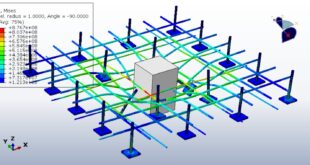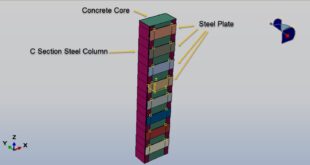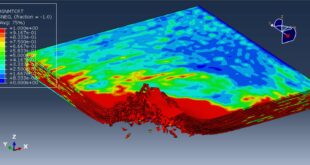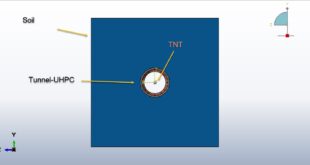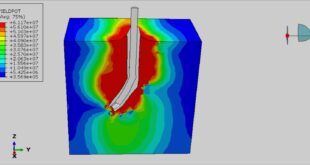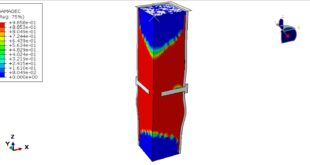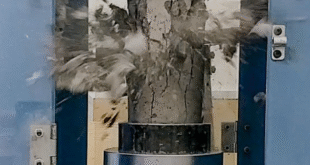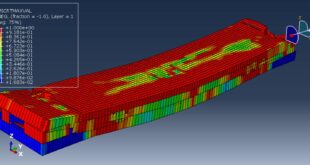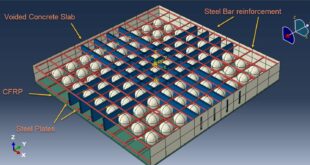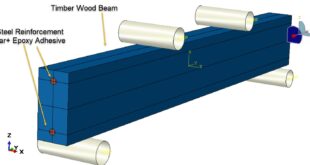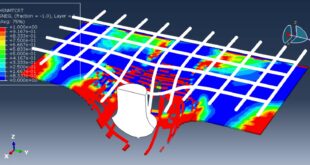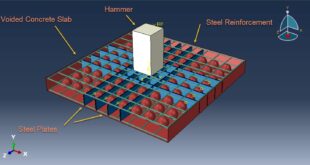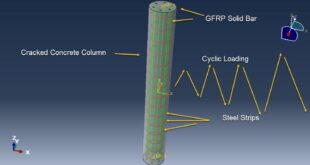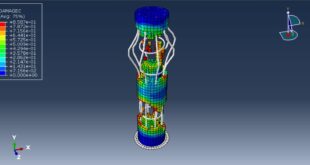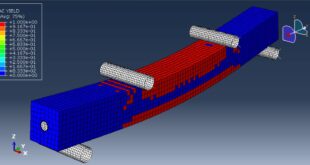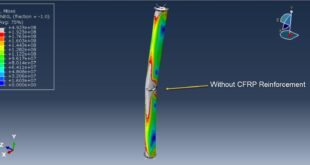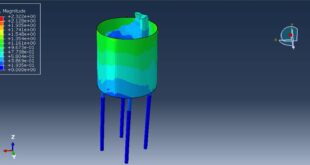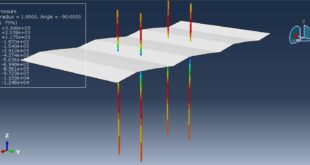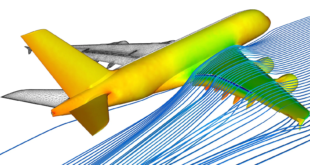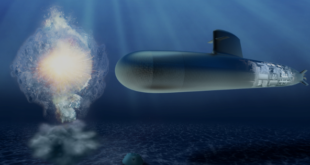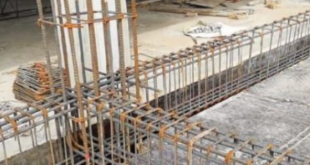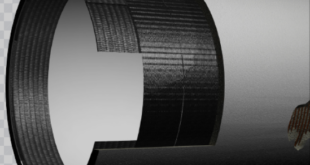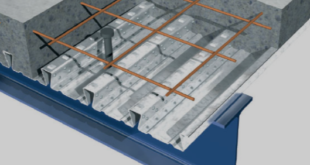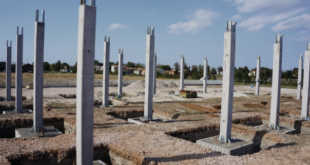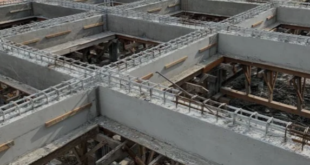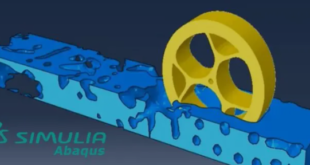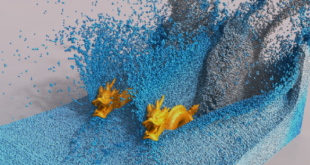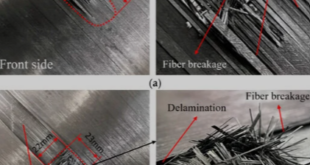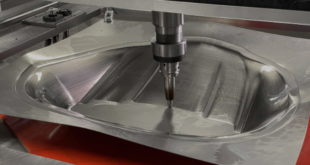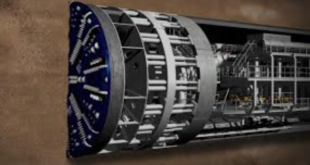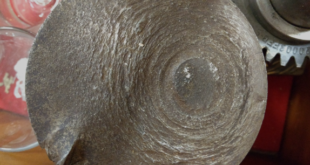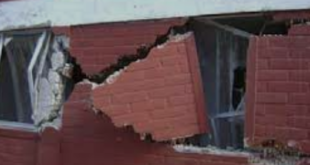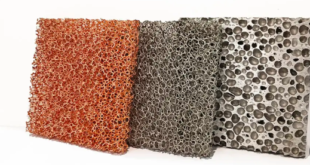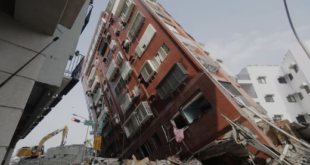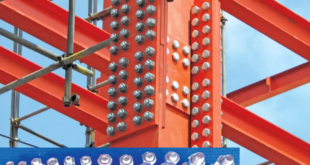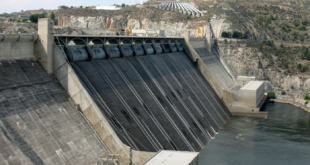In this tutorial, the Simulation of an RC slab reinforced with CFRP rods and fiber concrete jacket with a mechanical anchorage member under impact load has been done. Over the past few decades, the challenges associated with ageing and deterioration have become prominent issues in the construction field. Reinforced concrete ...
ادامه نوشته »Analysis of a Thin-walled C-section Steel Encased Concrete Composite Columns under compression load
In this tutorial, the Analysis of a Thin-walled C-section Steel Encased Concrete Composite column under compression load has been investigated. Thin-walled C-section steel encased concrete composite columns represent an innovative structural system that combines the advantages of both steel and concrete materials. These columns consist of cold-formed thin-walled steel C-sections ...
ادامه نوشته »Ballistic impact response of Kevlar reinforced Gelatin(Human Tissue)in Abaqus
Overview The study of ballistic impact on Kevlar-reinforced gelatin is crucial for understanding body armor performance, behind-armor blunt trauma (BABT), and wound ballistics. Gelatin is widely used as a soft tissue simulant due to its mechanical similarity to human muscle tissue, while Kevlar (a para-aramid fiber) is a common ballistic-resistant material used in protective gear ...
ادامه نوشته »Non-linear FE investigation of subsurface UHPC tunnel with GFRP protection against internal blast with CEL method
The increasing threat of blast loads on critical underground infrastructure has necessitated advanced protective measures for tunnels. Ultra-High Performance Concrete (UHPC) has emerged as an excellent material for blast-resistant structures due to its superior strength and energy absorption capacity. When combined with Glass Fiber-Reinforced Polymer (GFRP) protection, UHPC tunnels can ...
ادامه نوشته »Pull-out test analysis of a hooked GFRP bar embedded in the timber with epoxy interface
Introduction to Pull-out Test Analysis of a Hooked GFRP Bar Embedded in Timber with Epoxy Interface Background and Significance Fiber-reinforced polymer (FRP) bars, particularly glass-FRP (GFRP), are increasingly used as reinforcement in timber structures due to their high strength-to-weight ratio, corrosion resistance, and compatibility with wood. However, the bond behavior ...
ادامه نوشته »Simulation of bolts used as shear connectors in concrete-filled steel column in Abaqus
Introduction to Bolts as Shear Connectors in Concrete-Filled Steel Columns Overview In concrete-filled steel tube (CFST) columns, shear connectors are crucial for ensuring composite action between the steel tube and the enclosed concrete core. Bolts are increasingly used as shear connectors due to their ease of installation, adjustability, and effectiveness in transferring shear forces Role ...
ادامه نوشته »Concrete cylinder compression test under static and dynamic load in Abaqus
Introduction to the Concrete Cylinder Compression Test The concrete cylinder compression test is a standard method used to determine the compressive strength of hardened concrete, which is a key indicator of its quality and structural performance. This test is performed according to established standards such as ASTM C39 (American Society for Testing and Materials) or EN 12390-3 ...
ادامه نوشته »Simulation blast resistance behavior of adhesively bonded cross-laminated timber-concrete composite
Introduction to Simulation of Blast Resistance Behavior of Adhesively Bonded Cross-Laminated Timber-Concrete Composite (CLT-CC) Overview The simulation of blast resistance behavior in adhesively bonded cross-laminated timber-concrete composites (CLT-CC) represents an emerging area of research in structural engineering and blast mitigation. This composite system combines the advantages of cross-laminated timber (CLT) ...
ادامه نوشته »Blast resistance behavior of interior voided slab-column connections using steel sheets and CFRP reinforcement
Introduction to Blast Resistance Behavior of Interior Voided Slab-Column Connections Using Steel Sheets and CFRP Reinforcement Background and Significance Modern structures, particularly those in high-risk environments, require enhanced resistance to extreme loading conditions such as blast loads. Slab-column connections are critical zones in reinforced concrete (RC) frames, often susceptible to ...
ادامه نوشته »Flextural test of timber beams reinforced with steel bars and epoxy in Abaqus
Introduction to Flexural Testing of Timber Beams Reinforced with Steel Bars Overview The flexural test of timber beams reinforced with steel bars is an experimental procedure used to evaluate composite timber-steel structural elements’ bending strength, stiffness, and ductility. This test is essential for assessing how steel reinforcement enhances the mechanical ...
ادامه نوشته »Ballistic impact on the hybrid fiber reinforced concrete reinforced with CFRP sheet
Introduction to Bullet Ballistic Impact on Hybrid Fiber-Reinforced Concrete (HFRC) Reinforced with CFRP Sheets Background Hybrid Fiber-Reinforced Concrete (HFRC) combines different types of fibers (e.g., steel, polypropylene, basalt, or glass) to enhance mechanical properties such as tensile strength, ductility, and impact resistance. When further reinforced with Carbon Fiber-Reinforced Polymer (CFRP) ...
ادامه نوشته »Simulation and modeling of steel beam-to-CFST column connection with bolt in Abaqus
Introduction to Modeling Steel Beam-to-CFDST Column Connection with Bolts Overview of CFDST Columns and Steel Beam Connections Concrete-Filled Double-Skin Steel Tubular (CFDST) columns consist of two concentric steel tubes with concrete sandwiched between them. These columns offer high strength, ductility, and excellent seismic performance. When connecting a steel beam to ...
ادامه نوشته »Low-Velocity impact behavior of interior voided slab-column connections using steel sheets in Abaqus
Introduction to Low-Velocity Impact Behavior of Interior Voided Slab-Column Connections Using Steel Sheets Background Slab-column connections are critical structural elements in modern construction, particularly in flat-plate systems where shear resistance and punching strength are major concerns. Introducing voids within the slab (voided slabs) can reduce weight, improve material efficiency, and ...
ادامه نوشته »Simulation flexural behavior of steel-polypropylene hybrid fiber reinforced concrete reinforced with GFRP sheet in Abaqus
Introduction to Flexural Behavior of Steel-Polypropylene Hybrid Fiber Reinforced Concrete Reinforced with GFRP Sheet The flexural behavior of steel-polypropylene hybrid fiber reinforced concrete (SP-HFRC) reinforced with glass fiber reinforced polymer (GFRP) sheets represents an advanced composite material system that combines multiple reinforcement mechanisms to improve the mechanical performance of concrete ...
ادامه نوشته »Cyclic loading analysis of a cracked and damaged concrete column reinforced with GFRP bar
Introduction to Cyclic Loading Analysis of a Cracked Concrete Column Reinforced with GFRP Bars in Abaqus Cyclic loading analysis of damaged concrete columns reinforced with Glass Fiber-Reinforced Polymer (GFRP) bars is an important simulation for evaluating seismic performance and rehabilitation strategies. This analysis helps engineers understand how cracked concrete structures ...
ادامه نوشته »Finite element analysis of hybrid jute/basalt fiber reinforced polymer confined UHPC column under axial compression
Introduction to Finite Element Analysis of Hybrid Jute/Basalt Fiber Reinforced Polymer Confined UHPC Column under Axial Compression in Abaqus Overview of the Study Ultra-High Performance Concrete (UHPC) is known for its exceptional strength, durability, and ductility, making it suitable for high-performance structural applications. However, to further enhance its load-bearing capacity ...
ادامه نوشته »Numerical study on CFRP-lined concrete cylinder pipe under internal explosion
Introduction to Numerical Study on CFRP-Lined Concrete Cylinder Pipe (CCP) Under Internal Explosion Concrete Cylinder Pipes (CCPs) are widely used in water transmission systems due to their high load-bearing capacity and durability. However, they are vulnerable to internal explosions caused by accidental gas ignition or deliberate attacks, leading to catastrophic ...
ادامه نوشته »Simulation of Timber Wood beam Reinforced with GFRP Rod and Epoxy Interface under Bending Test
Introduction to Timber Wood Beam Reinforced with GFRP Rod and Epoxy Interface under Bending Test Overview The reinforcement of timber wood beams using Glass Fiber-Reinforced Polymer (GFRP) rods with an epoxy interface represents an innovative approach to enhancing the structural performance of traditional timber elements. This composite system combines the ...
ادامه نوشته »Simulation of wood-steel plate connection with bolt under tension load in Abaqus
A wood-steel plate connection with bolts is a common structural joint used in timber construction to transfer loads between wooden members and steel plates. This type of connection is widely used in beams, columns, trusses, and hybrid structures due to its strength, durability, and ease of assembly You can see a figure ...
ادامه نوشته »Strengthening of corroded steel column under axial compressive load using CFRP in Abaqus
Introduction to Strengthening Corroded Steel Columns with CFRP Corrosion in steel columns is a major concern in structural engineering, leading to reduced load-bearing capacity, stiffness, and overall structural integrity. Traditional repair methods, such as steel plate bonding or section enlargement, can be costly, labor-intensive, and sometimes impractical. Carbon Fiber Reinforced Polymer ...
ادامه نوشته »Seismic and Sloshing analysis of an airy CFRP composite tank in Abaqus
In this practical example, the Seismic and Sloshing analysis of an airy CFRP composite tank in Abaqus has been studied. Airy Carbon Fiber Reinforced Polymer (CFRP) composite tanks are widely used in aerospace, automotive, and energy storage applications due to their high strength-to-weight ratio, corrosion resistance, and durability. However, when ...
ادامه نوشته »Bullet penetration models using large deformation explicit finite element simulations of rapid penetration in soil
In this tutorial, the Bullet penetration model using large deformation explicit finite element simulations of rapid penetration in soil in Abaqus software has been studied. The bullet is modeled as a three-dimensional part, and the soil as an Eulerian model. You can see a figure of the assembled parts below ...
ادامه نوشته »Abaqus AQUA- a Riser Group under current, wave, and drag load analysis
Abaqus AQUA is a specialized module within the SIMULIA Abaqus finite element analysis (FEA) software that simulates the effects of hydrodynamic loads on offshore and marine structures. It is beneficial for analyzing structures exposed to waves, currents, and buoyancy forces, such as Offshore platforms (oil & gas rigs, wind turbines) Subsea pipelines Ship components Floating structures ...
ادامه نوشته »Offshore structure analysis in Abaqus AQUA
Introduction to Abaqus AQUA Simulation Abaqus AQUA is an advanced module within the SIMULIA Abaqus finite element analysis (FEA) software suite, specifically designed for simulating structures subjected to offshore and marine environments. It is particularly useful for analyzing the effects of wave, buoyancy, and hydrodynamic loading on offshore structures such as Oil & gas platforms Subsea ...
ادامه نوشته »Fluid-Structure Interaction (FSI) and CFD Analysis Package in Abaqus
Fluid-Structure Interaction (FSI) and CFD Analysis in Abaqus Introduction to Fluid-Structure Interaction (FSI) Fluid-Structure Interaction (FSI) is a multiphysics phenomenon where a fluid and a solid structure interact, leading to deformation in the structure and changes in the fluid flow. FSI problems are common in engineering applications such as Aerodynamics ...
ادامه نوشته »Underwater and Underground Explosion Package in Abaqus
Introduction to Underwater and Underground Explosion Phenomena in Abaqus Abaqus is a robust finite element analysis (FEA) software that simulates complex phenomena, including underwater and underground explosions. These simulations are crucial for defense applications, mining engineering, offshore structures, and protective design Underwater Explosions in Abaqus Rapid expansion of gas bubbles ...
ادامه نوشته »Ceramic and Silicon Carbide Package in Abaqus
Introduction to Ceramic and Silicon Carbide Materials Ceramics are inorganic, non-metallic materials known for their high hardness, thermal stability, and chemical resistance. They are typically made by heating natural minerals (like clay) or synthetic powders at high temperatures (sintering). Silicon carbide is an advanced ceramic and semiconductor material composed of ...
ادامه نوشته »Beam-Column Joints Analysis Package in Abaqus
Introduction to Beam-Column Joints in Civil Engineering In reinforced concrete (RC) and steel structures, the beam-column joint is a critical region where beams and columns intersect, transferring forces and moments between them. It plays a vital role in the overall stability, strength, and ductility of a structure, particularly under seismic loads Key ...
ادامه نوشته »Heat Transfer and Thermal Analysis Package in Abaqus
Introduction to Heat Transfer in Abaqus Abaqus is a powerful finite element analysis (FEA) software capable of modeling heat transfer problems. The heat transfer functionality in Abaqus allows engineers and researchers to simulate thermal processes in various engineering applications Key Capabilities of Heat Transfer in Abaqus Abaqus can handle three ...
ادامه نوشته »Pipe Simulation and Analysis Package in Abaqus
Introduction to Metal and Composite Pipes Pipes are essential in various industries, including oil and gas, water supply, chemical processing, and construction. They are used to transport fluids, gases, and sometimes solids. Two common types of pipes are metal pipes and composite pipes, each with unique properties and applications Metal Pipes Metal ...
ادامه نوشته »Concrete and Composite Slab Analysis Package in Abaqus
Introduction to Concrete and Composite Slabs in Abaqus Abaqus is a powerful finite element analysis (FEA) software widely used to simulate the behavior of complex structures, including concrete and composite slabs. Concrete slabs are fundamental structural elements used in construction to provide flat, horizontal surfaces such as floors, roofs, and ...
ادامه نوشته »Concrete and Steel Column Package in Abaqus
Introduction to concrete and steel columns Concrete and steel columns are fundamental structural elements used to support loads and transfer them to the foundation. They are essential components in buildings, bridges, and other structures, providing stability, strength, and durability. Here’s an introduction to both types of columns Concrete Columns Concrete ...
ادامه نوشته »Concrete and Steel Beam Package in Aabqus
Introduction to Concrete and Steel Beams Concrete and steel beams are fundamental structural elements used to support loads and stabilize buildings, bridges, and other structures. Both materials have unique properties that make them suitable for different applications, and they are often used in combination to optimize strength, durability, and cost-effectiveness ...
ادامه نوشته »CEL and Eulerian Analysis Package in Abaqus
In Abaqus, CEL (Coupled Eulerian-Lagrangian) and Eulerian analysis are advanced techniques used to model complex problems involving large deformations, fluid-structure interactions, and multiphase flows. These methods are particularly useful when traditional Lagrangian approaches struggle to handle severe mesh distortions or when fluid behavior dominates the problem Eulerian Analysis Eulerian analysis is a framework where ...
ادامه نوشته »DEM and SPH Package in Abaqus
The Discrete Element Method (DEM) is a numerical technique used to model the behavior of granular materials, such as soil, powders, grains, and other particulate systems. Unlike continuum-based methods (e.g., Finite Element Method or FEM), DEM treats materials as a collection of individual particles or discrete elements that interact with each other ...
ادامه نوشته »Water and Air Simulation and Analysis Package in Abaqus
Simulating water and air (or fluids in general) in Abaqus can be a complex but enriching task, especially when dealing with fluid-structure interaction (FSI) problems. Below is a detailed lecture-style explanation of how to approach water and air simulation in Abaqus Water and Air Simulation in Abaqus Introduction to Fluid ...
ادامه نوشته »Composite Simulation and Analysis Package in Abaqus
Introduction to Composite Materials Composite materials are engineered materials made from two or more constituent materials with significantly different physical or chemical properties. When combined, these materials produce a material with characteristics different from the individual components. The primary constituents of composites are Matrix: The continuous phase that binds the ...
ادامه نوشته »Sloshing Analysis and Simulation Package in Abaqus
Sloshing Analysis and Simulation in Abaqus Sloshing refers to the movement of liquid inside a partially filled container due to external forces such as vibrations, accelerations, or seismic activity. This phenomenon is critical in various industries, including aerospace, automotive, marine, and civil engineering, where the dynamic behavior of liquids in ...
ادامه نوشته »Forming Simulation and Analysis Package in Abaqus
Forming Simulation and Analysis in Abaqus Forming simulation and analysis in Abaqus is a powerful tool used to model and predict the behavior of materials during manufacturing processes such as stamping, forging, rolling, and extrusion. Abaqus, a leading finite element analysis (FEA) software, provides advanced capabilities to simulate complex forming ...
ادامه نوشته »Brittle Damage Package in Abaqus- Johnson-Holmquis and Beissel Model
Introduction to Brittle Damage Modeling in Abaqus: Johnson-Holmquist and Beissel Models Brittle damage refers to the failure mechanism observed in brittle materials such as concrete, glass, ice, and ceramics. Unlike ductile materials, which undergo significant plastic deformation before failure, brittle materials typically fail suddenly with little to no warning and ...
ادامه نوشته »Tunnel and TBM Simulation Package in Abaqus
Introduction to Tunnel and TBM Simulation in Abaqus Abaqus is a powerful finite element analysis (FEA) software widely used in engineering and scientific research. It is particularly effective for simulating complex geotechnical problems, including tunnel construction and Tunnel Boring Machine (TBM) operations. Simulating tunnels and TBMs in Abaqus allows engineers ...
ادامه نوشته »Fatigue and Cyclic Loading Package in Abaqus
Fatigue and Cyclic Loading in Abaqus Mechanical fatigue is a phenomenon where a material undergoes progressive and localized structural damage when subjected to cyclic or fluctuating stresses, even if these stresses are below the material’s ultimate tensile strength. Over time, this repeated loading and unloading can lead to the initiation ...
ادامه نوشته »Ultra-High-Performance-Fiber-Reinforced-Concrete(UHPFRC) Package in Abaqus
Ultra-High-Performance Fiber-Reinforced Concrete (UHPFRC) in Abaqus Ultra-high-performance fiber-reinforced Concrete (UHPFRC) is an advanced construction material characterized by its exceptional mechanical properties, including high compressive strength, tensile strength, and durability. UHPFRC is typically composed of a dense matrix of fine particles, high-strength cement, and steel or synthetic fibers, which enhance its ...
ادامه نوشته »Ultra-High-Performance-Concrete(UHPC) Package in Abaqus
Introduction to Ultra-High-Performance Concrete (UHPC) in Abaqus Ultra-high-performance concrete (UHPC) is an advanced cementitious material characterized by its exceptional strength, durability, and ductility. It typically has a compressive strength exceeding 150 MPa and can reach up to 250 MPa or higher, along with superior tensile strength and resistance to environmental ...
ادامه نوشته »Masonry Wall and Structure Package in Abaqus
Introduction to Masonry Wall and Structure Simulation in Abaqus Masonry walls are structural elements made from individual units (such as bricks, stones, or concrete blocks) bound together by mortar. They are widely used in construction due to their durability, thermal insulation, and aesthetic appeal. However, simulating masonry structures can be ...
ادامه نوشته »Polymer and Metal Foam Simulation Package-Abaqus
Introduction to Polymeric and Metal Foam Simulation in Abaqus Polymeric and metal foam are advanced materials widely used in industries such as aerospace, automotive, biomedical, and construction due to their unique properties, including high strength-to-weight ratios, energy absorption, and thermal and acoustic insulation. Simulating these materials in Abaqus, a powerful ...
ادامه نوشته »Earthquake and Seismic Analysis Package in Abaqus
Introduction to Earthquake and Seismic Analysis in Abaqus Earthquake and seismic analysis are critical aspects of structural engineering, aimed at understanding and mitigating the effects of seismic events on structures. Abaqus, a powerful finite element analysis (FEA) software developed by Dassault Systèmes, is widely used for simulating and analyzing the ...
ادامه نوشته »Bolt Analysis and Simulation Package-Abaqus
Introduction to Bolt Analysis in Abaqus Abaqus is a powerful finite element analysis (FEA) software widely used for simulating complex mechanical systems, including bolted joints. Bolt analysis in Abaqus involves modeling the bolt, applying preload, and simulating the behavior of the bolted joint under various loading conditions. This analysis helps ...
ادامه نوشته »Dam Analysis Package in Abaqus
Introduction to Dam Simulation and Analysis in Abaqus Abaqus is a powerful finite element analysis (FEA) software widely used in engineering and scientific research for simulating complex physical behaviors. When it comes to dam simulation and analysis, Abaqus provides a comprehensive suite of tools to model, analyze, and predict the performance of ...
ادامه نوشته »Rock and Stone Analysis Package in Abaqus
Introduction to Rock and Stone Simulation and Analysis in Abaqus Rock and stone analysis in Abaqus software involves simulating the mechanical behavior of geological materials, such as rocks, stones, and other geomaterials, under various loading and environmental conditions. Abaqus, a powerful finite element analysis (FEA) software, is widely used in ...
ادامه نوشته » Abaqus tutorials Abaqus tutorials
Abaqus tutorials Abaqus tutorials
